Communication 100: Research Report on the Misuse of Media
VerifiedAdded on 2023/05/28
|12
|3771
|454
Report
AI Summary
This report examines the misuse of media, specifically focusing on cyberbullying and privacy concerns, and explores strategies for prevention. The paper begins with an introduction highlighting the significant role of media in contemporary society and the negative impacts of its misuse, such as loss of privacy and cyberbullying. It then presents an overview of four academic articles that investigate cyberbullying prevention strategies, including school-based interventions and the role of parenting practices. The report addresses two research questions: the effectiveness of school-based interventions in reducing cyberbullying and the role of parents and educators in preventing cyberbullying among children. The analysis reveals that school-based programs, integrated into the curriculum, are effective in creating a caring environment, developing clear anti-bullying policies, and implementing strategic procedural steps. The study also highlights the importance of effective parenting practices, including communication and supervision, in preventing cyberbullying. The report emphasizes the need for collaboration between schools, parents, and healthcare providers to implement comprehensive prevention programs.
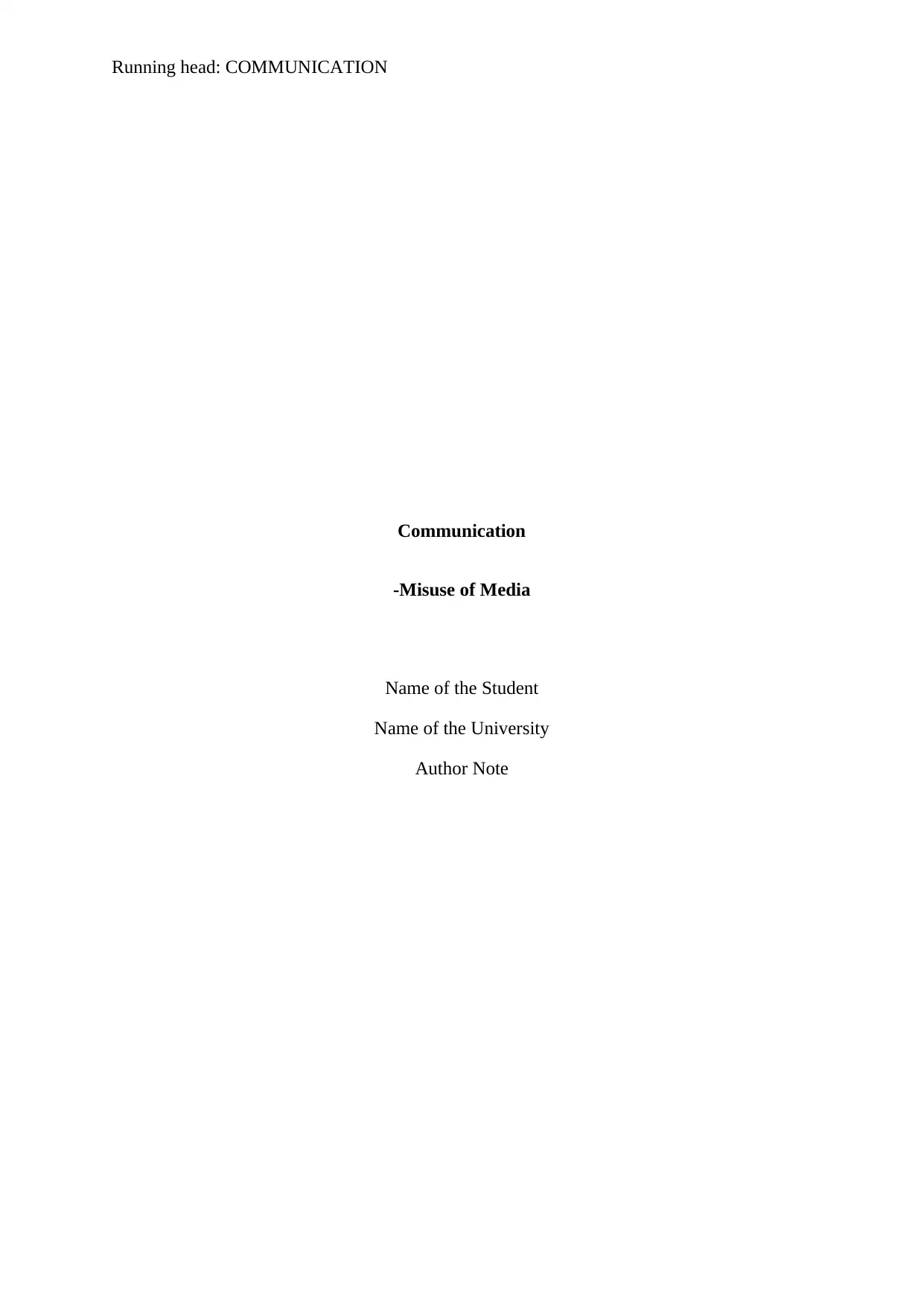
Running head: COMMUNICATION
Communication
-Misuse of Media
Name of the Student
Name of the University
Author Note
Communication
-Misuse of Media
Name of the Student
Name of the University
Author Note
Paraphrase This Document
Need a fresh take? Get an instant paraphrase of this document with our AI Paraphraser
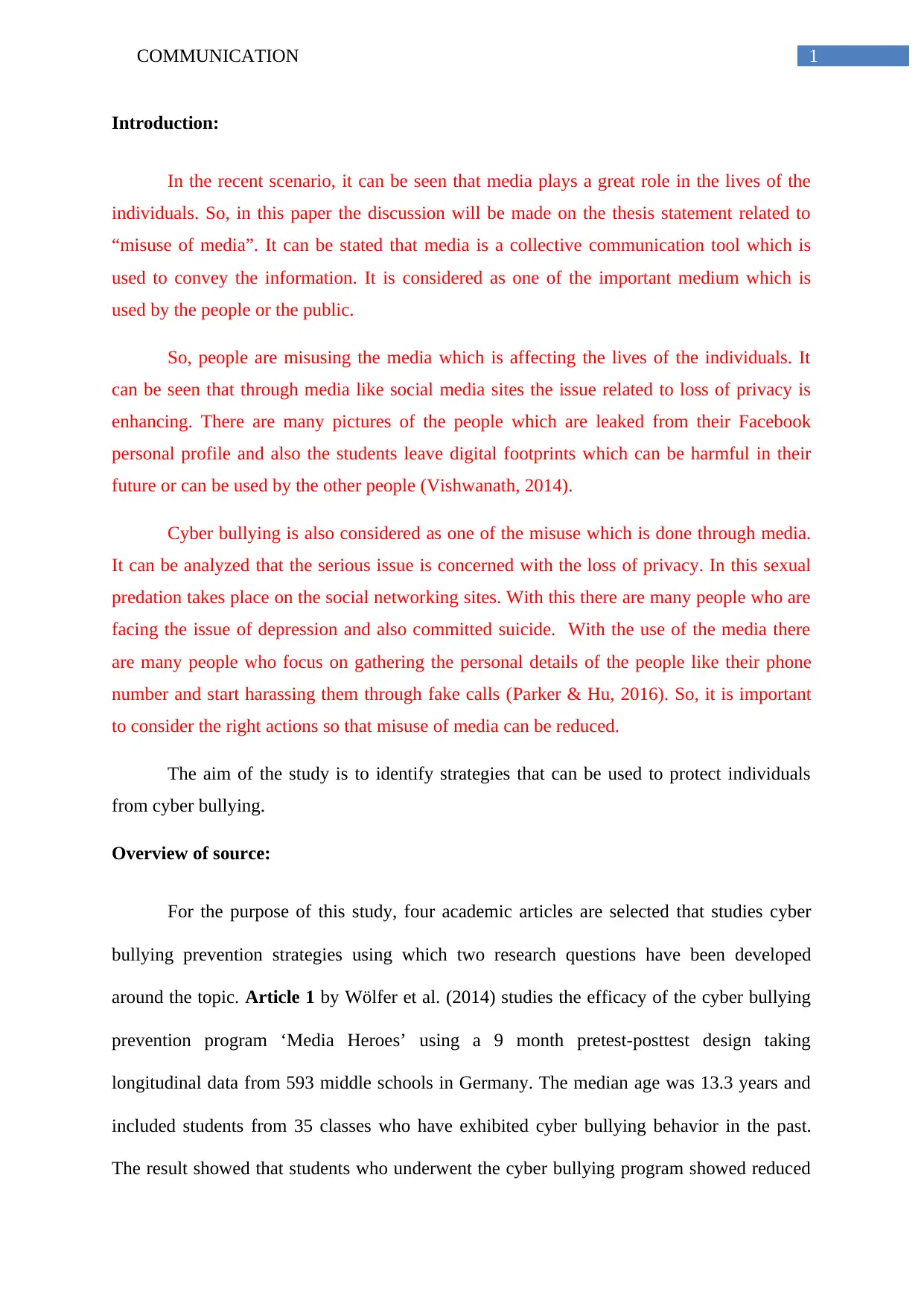
1COMMUNICATION
Introduction:
In the recent scenario, it can be seen that media plays a great role in the lives of the
individuals. So, in this paper the discussion will be made on the thesis statement related to
“misuse of media”. It can be stated that media is a collective communication tool which is
used to convey the information. It is considered as one of the important medium which is
used by the people or the public.
So, people are misusing the media which is affecting the lives of the individuals. It
can be seen that through media like social media sites the issue related to loss of privacy is
enhancing. There are many pictures of the people which are leaked from their Facebook
personal profile and also the students leave digital footprints which can be harmful in their
future or can be used by the other people (Vishwanath, 2014).
Cyber bullying is also considered as one of the misuse which is done through media.
It can be analyzed that the serious issue is concerned with the loss of privacy. In this sexual
predation takes place on the social networking sites. With this there are many people who are
facing the issue of depression and also committed suicide. With the use of the media there
are many people who focus on gathering the personal details of the people like their phone
number and start harassing them through fake calls (Parker & Hu, 2016). So, it is important
to consider the right actions so that misuse of media can be reduced.
The aim of the study is to identify strategies that can be used to protect individuals
from cyber bullying.
Overview of source:
For the purpose of this study, four academic articles are selected that studies cyber
bullying prevention strategies using which two research questions have been developed
around the topic. Article 1 by Wölfer et al. (2014) studies the efficacy of the cyber bullying
prevention program ‘Media Heroes’ using a 9 month pretest-posttest design taking
longitudinal data from 593 middle schools in Germany. The median age was 13.3 years and
included students from 35 classes who have exhibited cyber bullying behavior in the past.
The result showed that students who underwent the cyber bullying program showed reduced
Introduction:
In the recent scenario, it can be seen that media plays a great role in the lives of the
individuals. So, in this paper the discussion will be made on the thesis statement related to
“misuse of media”. It can be stated that media is a collective communication tool which is
used to convey the information. It is considered as one of the important medium which is
used by the people or the public.
So, people are misusing the media which is affecting the lives of the individuals. It
can be seen that through media like social media sites the issue related to loss of privacy is
enhancing. There are many pictures of the people which are leaked from their Facebook
personal profile and also the students leave digital footprints which can be harmful in their
future or can be used by the other people (Vishwanath, 2014).
Cyber bullying is also considered as one of the misuse which is done through media.
It can be analyzed that the serious issue is concerned with the loss of privacy. In this sexual
predation takes place on the social networking sites. With this there are many people who are
facing the issue of depression and also committed suicide. With the use of the media there
are many people who focus on gathering the personal details of the people like their phone
number and start harassing them through fake calls (Parker & Hu, 2016). So, it is important
to consider the right actions so that misuse of media can be reduced.
The aim of the study is to identify strategies that can be used to protect individuals
from cyber bullying.
Overview of source:
For the purpose of this study, four academic articles are selected that studies cyber
bullying prevention strategies using which two research questions have been developed
around the topic. Article 1 by Wölfer et al. (2014) studies the efficacy of the cyber bullying
prevention program ‘Media Heroes’ using a 9 month pretest-posttest design taking
longitudinal data from 593 middle schools in Germany. The median age was 13.3 years and
included students from 35 classes who have exhibited cyber bullying behavior in the past.
The result showed that students who underwent the cyber bullying program showed reduced
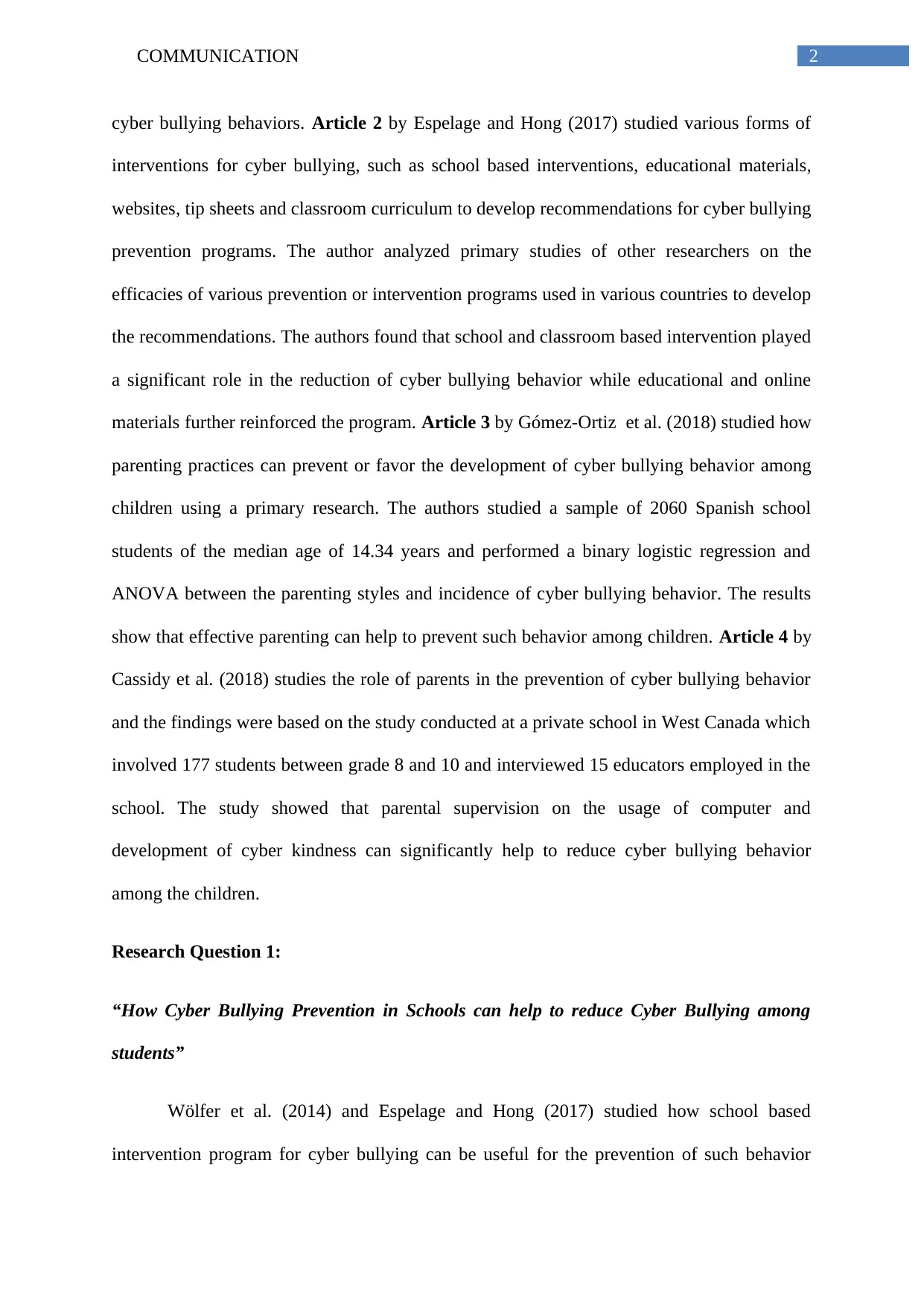
2COMMUNICATION
cyber bullying behaviors. Article 2 by Espelage and Hong (2017) studied various forms of
interventions for cyber bullying, such as school based interventions, educational materials,
websites, tip sheets and classroom curriculum to develop recommendations for cyber bullying
prevention programs. The author analyzed primary studies of other researchers on the
efficacies of various prevention or intervention programs used in various countries to develop
the recommendations. The authors found that school and classroom based intervention played
a significant role in the reduction of cyber bullying behavior while educational and online
materials further reinforced the program. Article 3 by Gómez-Ortiz et al. (2018) studied how
parenting practices can prevent or favor the development of cyber bullying behavior among
children using a primary research. The authors studied a sample of 2060 Spanish school
students of the median age of 14.34 years and performed a binary logistic regression and
ANOVA between the parenting styles and incidence of cyber bullying behavior. The results
show that effective parenting can help to prevent such behavior among children. Article 4 by
Cassidy et al. (2018) studies the role of parents in the prevention of cyber bullying behavior
and the findings were based on the study conducted at a private school in West Canada which
involved 177 students between grade 8 and 10 and interviewed 15 educators employed in the
school. The study showed that parental supervision on the usage of computer and
development of cyber kindness can significantly help to reduce cyber bullying behavior
among the children.
Research Question 1:
“How Cyber Bullying Prevention in Schools can help to reduce Cyber Bullying among
students”
Wölfer et al. (2014) and Espelage and Hong (2017) studied how school based
intervention program for cyber bullying can be useful for the prevention of such behavior
cyber bullying behaviors. Article 2 by Espelage and Hong (2017) studied various forms of
interventions for cyber bullying, such as school based interventions, educational materials,
websites, tip sheets and classroom curriculum to develop recommendations for cyber bullying
prevention programs. The author analyzed primary studies of other researchers on the
efficacies of various prevention or intervention programs used in various countries to develop
the recommendations. The authors found that school and classroom based intervention played
a significant role in the reduction of cyber bullying behavior while educational and online
materials further reinforced the program. Article 3 by Gómez-Ortiz et al. (2018) studied how
parenting practices can prevent or favor the development of cyber bullying behavior among
children using a primary research. The authors studied a sample of 2060 Spanish school
students of the median age of 14.34 years and performed a binary logistic regression and
ANOVA between the parenting styles and incidence of cyber bullying behavior. The results
show that effective parenting can help to prevent such behavior among children. Article 4 by
Cassidy et al. (2018) studies the role of parents in the prevention of cyber bullying behavior
and the findings were based on the study conducted at a private school in West Canada which
involved 177 students between grade 8 and 10 and interviewed 15 educators employed in the
school. The study showed that parental supervision on the usage of computer and
development of cyber kindness can significantly help to reduce cyber bullying behavior
among the children.
Research Question 1:
“How Cyber Bullying Prevention in Schools can help to reduce Cyber Bullying among
students”
Wölfer et al. (2014) and Espelage and Hong (2017) studied how school based
intervention program for cyber bullying can be useful for the prevention of such behavior
⊘ This is a preview!⊘
Do you want full access?
Subscribe today to unlock all pages.

Trusted by 1+ million students worldwide
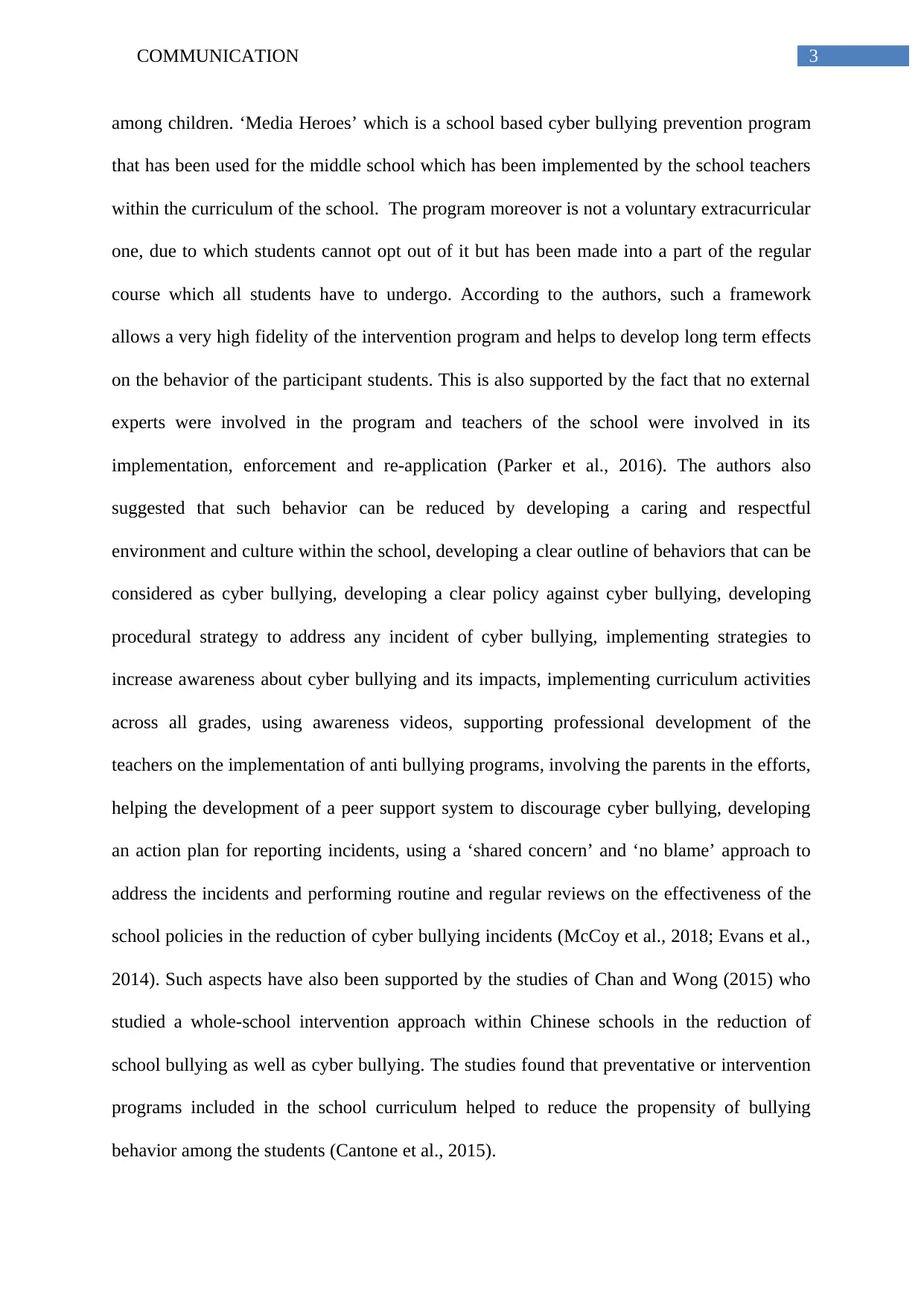
3COMMUNICATION
among children. ‘Media Heroes’ which is a school based cyber bullying prevention program
that has been used for the middle school which has been implemented by the school teachers
within the curriculum of the school. The program moreover is not a voluntary extracurricular
one, due to which students cannot opt out of it but has been made into a part of the regular
course which all students have to undergo. According to the authors, such a framework
allows a very high fidelity of the intervention program and helps to develop long term effects
on the behavior of the participant students. This is also supported by the fact that no external
experts were involved in the program and teachers of the school were involved in its
implementation, enforcement and re-application (Parker et al., 2016). The authors also
suggested that such behavior can be reduced by developing a caring and respectful
environment and culture within the school, developing a clear outline of behaviors that can be
considered as cyber bullying, developing a clear policy against cyber bullying, developing
procedural strategy to address any incident of cyber bullying, implementing strategies to
increase awareness about cyber bullying and its impacts, implementing curriculum activities
across all grades, using awareness videos, supporting professional development of the
teachers on the implementation of anti bullying programs, involving the parents in the efforts,
helping the development of a peer support system to discourage cyber bullying, developing
an action plan for reporting incidents, using a ‘shared concern’ and ‘no blame’ approach to
address the incidents and performing routine and regular reviews on the effectiveness of the
school policies in the reduction of cyber bullying incidents (McCoy et al., 2018; Evans et al.,
2014). Such aspects have also been supported by the studies of Chan and Wong (2015) who
studied a whole-school intervention approach within Chinese schools in the reduction of
school bullying as well as cyber bullying. The studies found that preventative or intervention
programs included in the school curriculum helped to reduce the propensity of bullying
behavior among the students (Cantone et al., 2015).
among children. ‘Media Heroes’ which is a school based cyber bullying prevention program
that has been used for the middle school which has been implemented by the school teachers
within the curriculum of the school. The program moreover is not a voluntary extracurricular
one, due to which students cannot opt out of it but has been made into a part of the regular
course which all students have to undergo. According to the authors, such a framework
allows a very high fidelity of the intervention program and helps to develop long term effects
on the behavior of the participant students. This is also supported by the fact that no external
experts were involved in the program and teachers of the school were involved in its
implementation, enforcement and re-application (Parker et al., 2016). The authors also
suggested that such behavior can be reduced by developing a caring and respectful
environment and culture within the school, developing a clear outline of behaviors that can be
considered as cyber bullying, developing a clear policy against cyber bullying, developing
procedural strategy to address any incident of cyber bullying, implementing strategies to
increase awareness about cyber bullying and its impacts, implementing curriculum activities
across all grades, using awareness videos, supporting professional development of the
teachers on the implementation of anti bullying programs, involving the parents in the efforts,
helping the development of a peer support system to discourage cyber bullying, developing
an action plan for reporting incidents, using a ‘shared concern’ and ‘no blame’ approach to
address the incidents and performing routine and regular reviews on the effectiveness of the
school policies in the reduction of cyber bullying incidents (McCoy et al., 2018; Evans et al.,
2014). Such aspects have also been supported by the studies of Chan and Wong (2015) who
studied a whole-school intervention approach within Chinese schools in the reduction of
school bullying as well as cyber bullying. The studies found that preventative or intervention
programs included in the school curriculum helped to reduce the propensity of bullying
behavior among the students (Cantone et al., 2015).
Paraphrase This Document
Need a fresh take? Get an instant paraphrase of this document with our AI Paraphraser
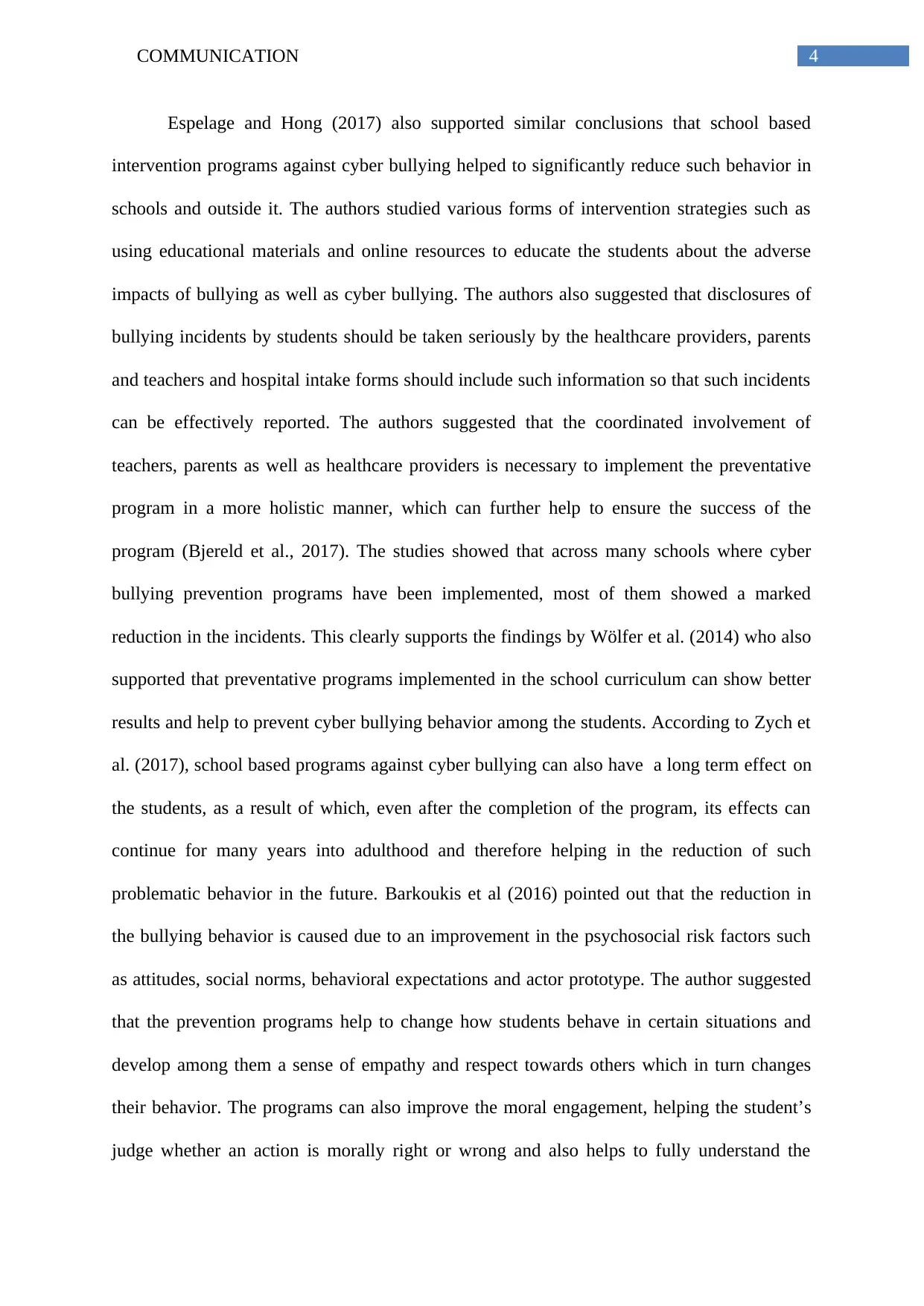
4COMMUNICATION
Espelage and Hong (2017) also supported similar conclusions that school based
intervention programs against cyber bullying helped to significantly reduce such behavior in
schools and outside it. The authors studied various forms of intervention strategies such as
using educational materials and online resources to educate the students about the adverse
impacts of bullying as well as cyber bullying. The authors also suggested that disclosures of
bullying incidents by students should be taken seriously by the healthcare providers, parents
and teachers and hospital intake forms should include such information so that such incidents
can be effectively reported. The authors suggested that the coordinated involvement of
teachers, parents as well as healthcare providers is necessary to implement the preventative
program in a more holistic manner, which can further help to ensure the success of the
program (Bjereld et al., 2017). The studies showed that across many schools where cyber
bullying prevention programs have been implemented, most of them showed a marked
reduction in the incidents. This clearly supports the findings by Wölfer et al. (2014) who also
supported that preventative programs implemented in the school curriculum can show better
results and help to prevent cyber bullying behavior among the students. According to Zych et
al. (2017), school based programs against cyber bullying can also have a long term effect on
the students, as a result of which, even after the completion of the program, its effects can
continue for many years into adulthood and therefore helping in the reduction of such
problematic behavior in the future. Barkoukis et al (2016) pointed out that the reduction in
the bullying behavior is caused due to an improvement in the psychosocial risk factors such
as attitudes, social norms, behavioral expectations and actor prototype. The author suggested
that the prevention programs help to change how students behave in certain situations and
develop among them a sense of empathy and respect towards others which in turn changes
their behavior. The programs can also improve the moral engagement, helping the student’s
judge whether an action is morally right or wrong and also helps to fully understand the
Espelage and Hong (2017) also supported similar conclusions that school based
intervention programs against cyber bullying helped to significantly reduce such behavior in
schools and outside it. The authors studied various forms of intervention strategies such as
using educational materials and online resources to educate the students about the adverse
impacts of bullying as well as cyber bullying. The authors also suggested that disclosures of
bullying incidents by students should be taken seriously by the healthcare providers, parents
and teachers and hospital intake forms should include such information so that such incidents
can be effectively reported. The authors suggested that the coordinated involvement of
teachers, parents as well as healthcare providers is necessary to implement the preventative
program in a more holistic manner, which can further help to ensure the success of the
program (Bjereld et al., 2017). The studies showed that across many schools where cyber
bullying prevention programs have been implemented, most of them showed a marked
reduction in the incidents. This clearly supports the findings by Wölfer et al. (2014) who also
supported that preventative programs implemented in the school curriculum can show better
results and help to prevent cyber bullying behavior among the students. According to Zych et
al. (2017), school based programs against cyber bullying can also have a long term effect on
the students, as a result of which, even after the completion of the program, its effects can
continue for many years into adulthood and therefore helping in the reduction of such
problematic behavior in the future. Barkoukis et al (2016) pointed out that the reduction in
the bullying behavior is caused due to an improvement in the psychosocial risk factors such
as attitudes, social norms, behavioral expectations and actor prototype. The author suggested
that the prevention programs help to change how students behave in certain situations and
develop among them a sense of empathy and respect towards others which in turn changes
their behavior. The programs can also improve the moral engagement, helping the student’s
judge whether an action is morally right or wrong and also helps to fully understand the
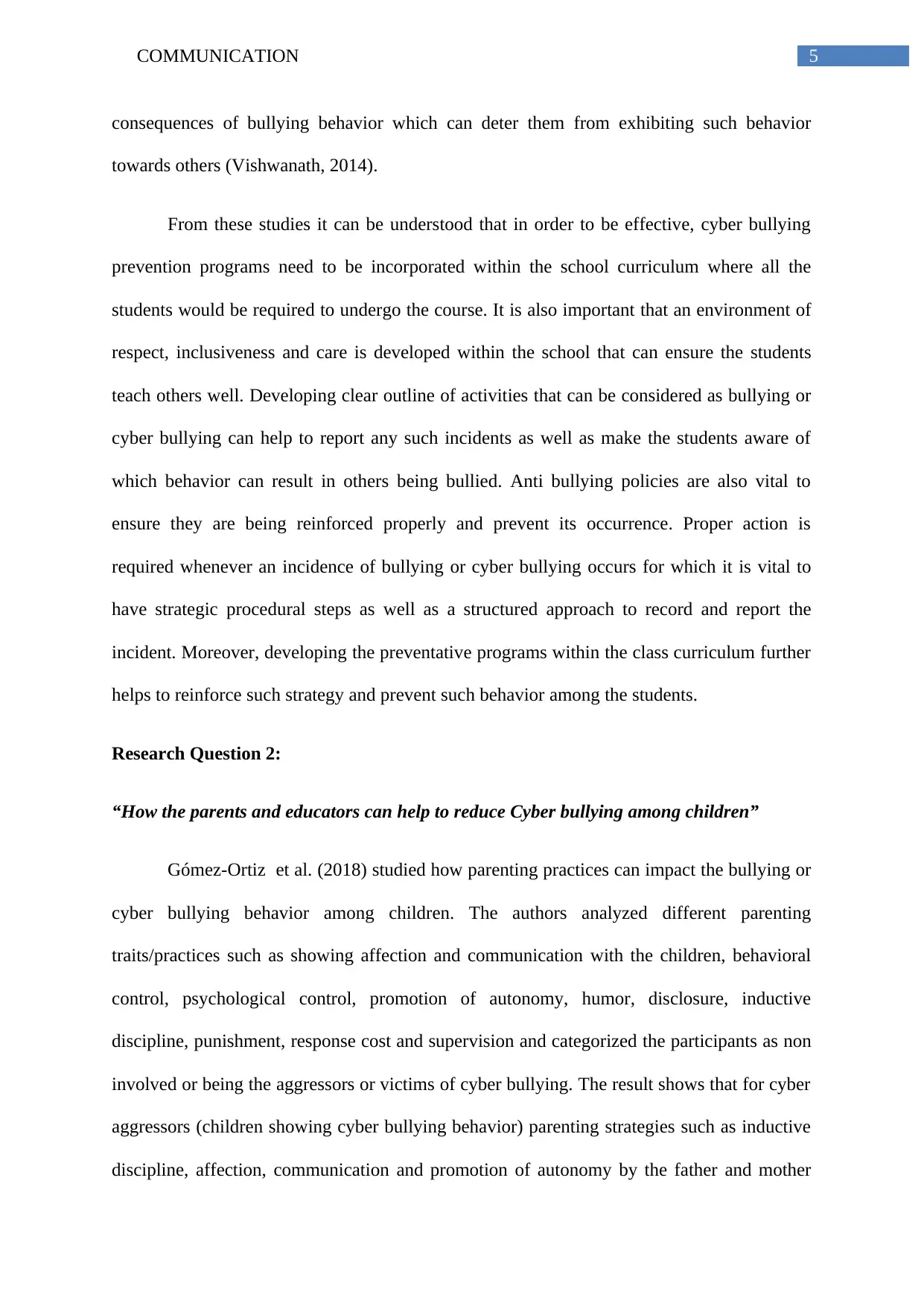
5COMMUNICATION
consequences of bullying behavior which can deter them from exhibiting such behavior
towards others (Vishwanath, 2014).
From these studies it can be understood that in order to be effective, cyber bullying
prevention programs need to be incorporated within the school curriculum where all the
students would be required to undergo the course. It is also important that an environment of
respect, inclusiveness and care is developed within the school that can ensure the students
teach others well. Developing clear outline of activities that can be considered as bullying or
cyber bullying can help to report any such incidents as well as make the students aware of
which behavior can result in others being bullied. Anti bullying policies are also vital to
ensure they are being reinforced properly and prevent its occurrence. Proper action is
required whenever an incidence of bullying or cyber bullying occurs for which it is vital to
have strategic procedural steps as well as a structured approach to record and report the
incident. Moreover, developing the preventative programs within the class curriculum further
helps to reinforce such strategy and prevent such behavior among the students.
Research Question 2:
“How the parents and educators can help to reduce Cyber bullying among children”
Gómez-Ortiz et al. (2018) studied how parenting practices can impact the bullying or
cyber bullying behavior among children. The authors analyzed different parenting
traits/practices such as showing affection and communication with the children, behavioral
control, psychological control, promotion of autonomy, humor, disclosure, inductive
discipline, punishment, response cost and supervision and categorized the participants as non
involved or being the aggressors or victims of cyber bullying. The result shows that for cyber
aggressors (children showing cyber bullying behavior) parenting strategies such as inductive
discipline, affection, communication and promotion of autonomy by the father and mother
consequences of bullying behavior which can deter them from exhibiting such behavior
towards others (Vishwanath, 2014).
From these studies it can be understood that in order to be effective, cyber bullying
prevention programs need to be incorporated within the school curriculum where all the
students would be required to undergo the course. It is also important that an environment of
respect, inclusiveness and care is developed within the school that can ensure the students
teach others well. Developing clear outline of activities that can be considered as bullying or
cyber bullying can help to report any such incidents as well as make the students aware of
which behavior can result in others being bullied. Anti bullying policies are also vital to
ensure they are being reinforced properly and prevent its occurrence. Proper action is
required whenever an incidence of bullying or cyber bullying occurs for which it is vital to
have strategic procedural steps as well as a structured approach to record and report the
incident. Moreover, developing the preventative programs within the class curriculum further
helps to reinforce such strategy and prevent such behavior among the students.
Research Question 2:
“How the parents and educators can help to reduce Cyber bullying among children”
Gómez-Ortiz et al. (2018) studied how parenting practices can impact the bullying or
cyber bullying behavior among children. The authors analyzed different parenting
traits/practices such as showing affection and communication with the children, behavioral
control, psychological control, promotion of autonomy, humor, disclosure, inductive
discipline, punishment, response cost and supervision and categorized the participants as non
involved or being the aggressors or victims of cyber bullying. The result shows that for cyber
aggressors (children showing cyber bullying behavior) parenting strategies such as inductive
discipline, affection, communication and promotion of autonomy by the father and mother
⊘ This is a preview!⊘
Do you want full access?
Subscribe today to unlock all pages.

Trusted by 1+ million students worldwide
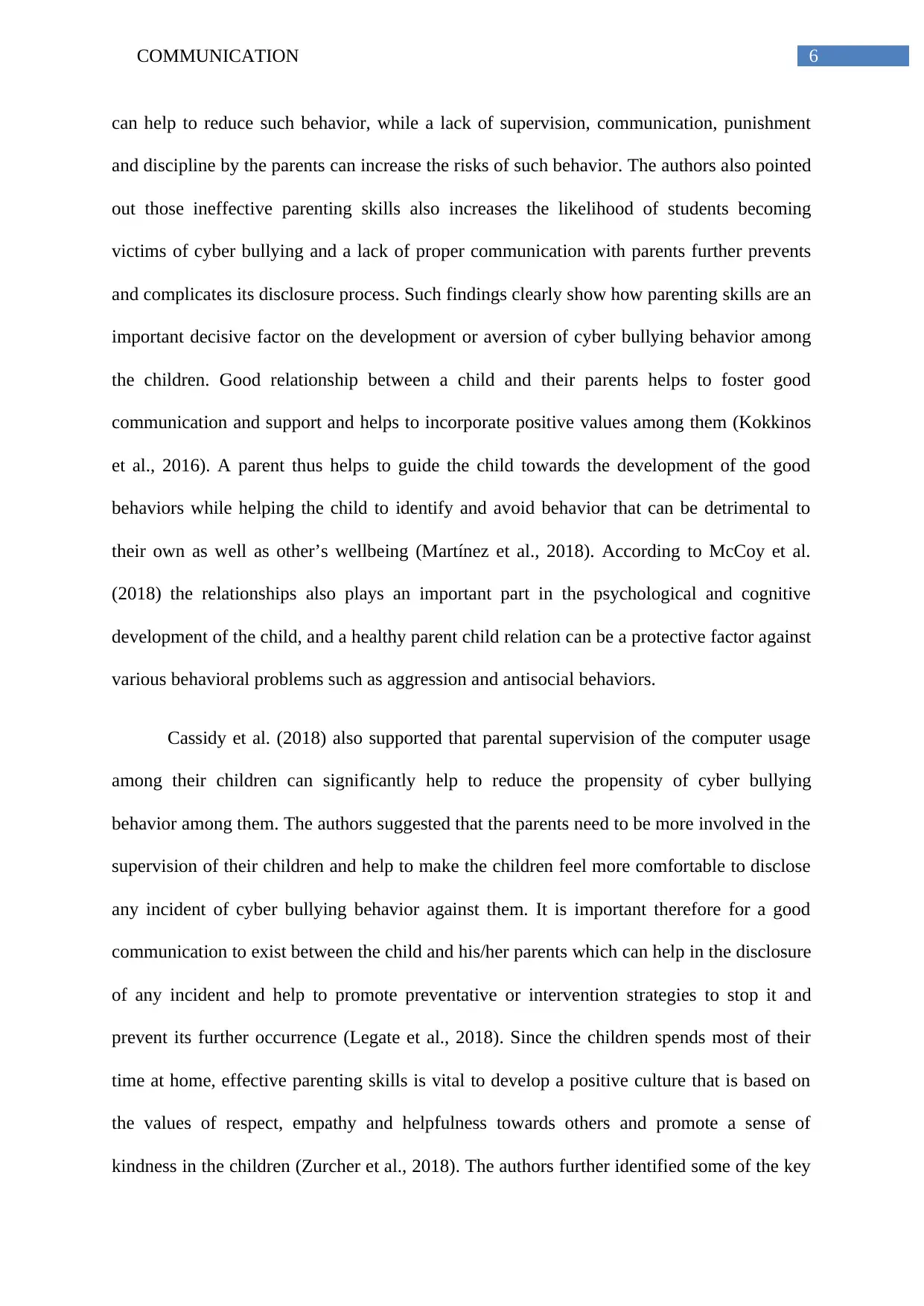
6COMMUNICATION
can help to reduce such behavior, while a lack of supervision, communication, punishment
and discipline by the parents can increase the risks of such behavior. The authors also pointed
out those ineffective parenting skills also increases the likelihood of students becoming
victims of cyber bullying and a lack of proper communication with parents further prevents
and complicates its disclosure process. Such findings clearly show how parenting skills are an
important decisive factor on the development or aversion of cyber bullying behavior among
the children. Good relationship between a child and their parents helps to foster good
communication and support and helps to incorporate positive values among them (Kokkinos
et al., 2016). A parent thus helps to guide the child towards the development of the good
behaviors while helping the child to identify and avoid behavior that can be detrimental to
their own as well as other’s wellbeing (Martínez et al., 2018). According to McCoy et al.
(2018) the relationships also plays an important part in the psychological and cognitive
development of the child, and a healthy parent child relation can be a protective factor against
various behavioral problems such as aggression and antisocial behaviors.
Cassidy et al. (2018) also supported that parental supervision of the computer usage
among their children can significantly help to reduce the propensity of cyber bullying
behavior among them. The authors suggested that the parents need to be more involved in the
supervision of their children and help to make the children feel more comfortable to disclose
any incident of cyber bullying behavior against them. It is important therefore for a good
communication to exist between the child and his/her parents which can help in the disclosure
of any incident and help to promote preventative or intervention strategies to stop it and
prevent its further occurrence (Legate et al., 2018). Since the children spends most of their
time at home, effective parenting skills is vital to develop a positive culture that is based on
the values of respect, empathy and helpfulness towards others and promote a sense of
kindness in the children (Zurcher et al., 2018). The authors further identified some of the key
can help to reduce such behavior, while a lack of supervision, communication, punishment
and discipline by the parents can increase the risks of such behavior. The authors also pointed
out those ineffective parenting skills also increases the likelihood of students becoming
victims of cyber bullying and a lack of proper communication with parents further prevents
and complicates its disclosure process. Such findings clearly show how parenting skills are an
important decisive factor on the development or aversion of cyber bullying behavior among
the children. Good relationship between a child and their parents helps to foster good
communication and support and helps to incorporate positive values among them (Kokkinos
et al., 2016). A parent thus helps to guide the child towards the development of the good
behaviors while helping the child to identify and avoid behavior that can be detrimental to
their own as well as other’s wellbeing (Martínez et al., 2018). According to McCoy et al.
(2018) the relationships also plays an important part in the psychological and cognitive
development of the child, and a healthy parent child relation can be a protective factor against
various behavioral problems such as aggression and antisocial behaviors.
Cassidy et al. (2018) also supported that parental supervision of the computer usage
among their children can significantly help to reduce the propensity of cyber bullying
behavior among them. The authors suggested that the parents need to be more involved in the
supervision of their children and help to make the children feel more comfortable to disclose
any incident of cyber bullying behavior against them. It is important therefore for a good
communication to exist between the child and his/her parents which can help in the disclosure
of any incident and help to promote preventative or intervention strategies to stop it and
prevent its further occurrence (Legate et al., 2018). Since the children spends most of their
time at home, effective parenting skills is vital to develop a positive culture that is based on
the values of respect, empathy and helpfulness towards others and promote a sense of
kindness in the children (Zurcher et al., 2018). The authors further identified some of the key
Paraphrase This Document
Need a fresh take? Get an instant paraphrase of this document with our AI Paraphraser
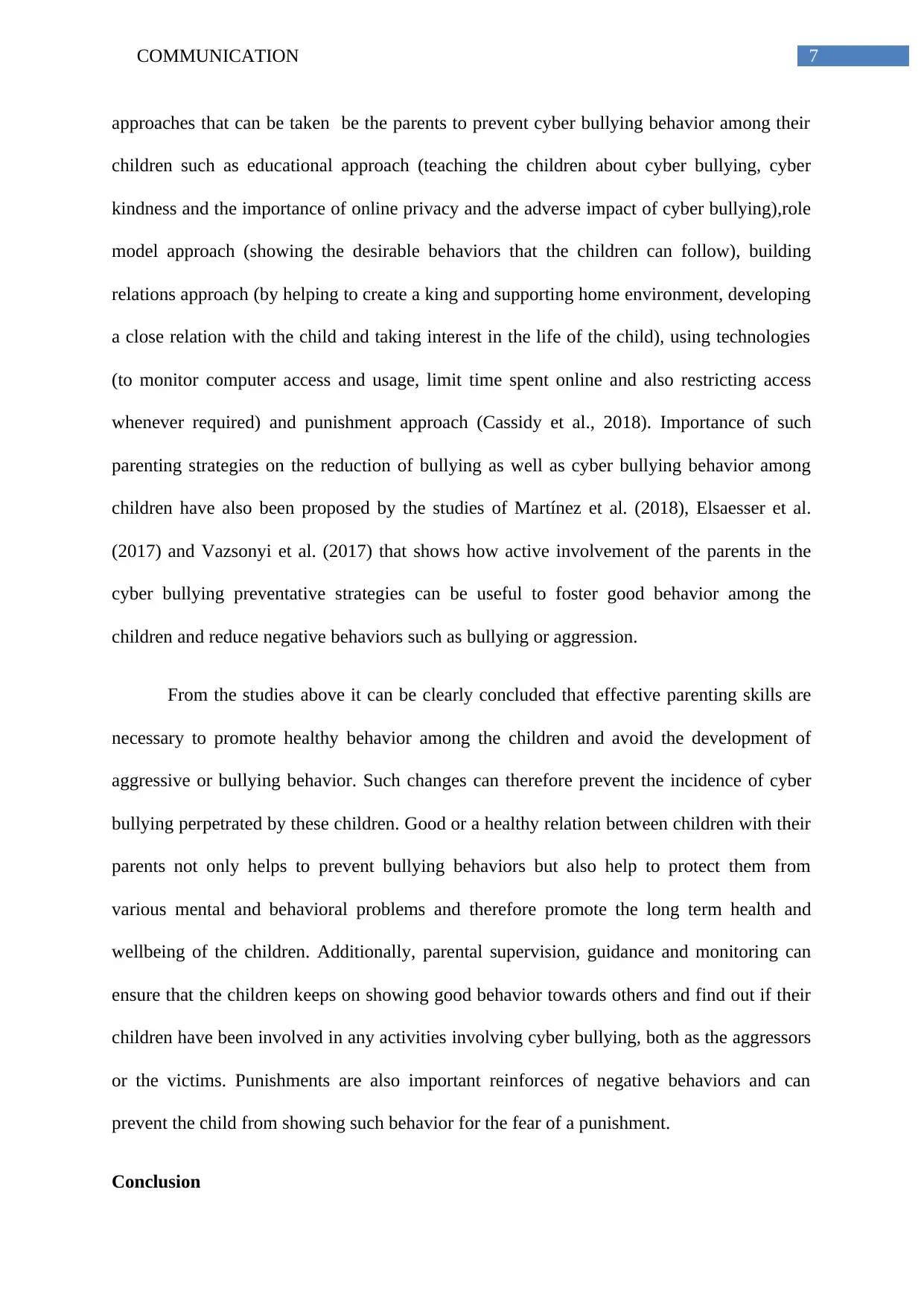
7COMMUNICATION
approaches that can be taken be the parents to prevent cyber bullying behavior among their
children such as educational approach (teaching the children about cyber bullying, cyber
kindness and the importance of online privacy and the adverse impact of cyber bullying),role
model approach (showing the desirable behaviors that the children can follow), building
relations approach (by helping to create a king and supporting home environment, developing
a close relation with the child and taking interest in the life of the child), using technologies
(to monitor computer access and usage, limit time spent online and also restricting access
whenever required) and punishment approach (Cassidy et al., 2018). Importance of such
parenting strategies on the reduction of bullying as well as cyber bullying behavior among
children have also been proposed by the studies of Martínez et al. (2018), Elsaesser et al.
(2017) and Vazsonyi et al. (2017) that shows how active involvement of the parents in the
cyber bullying preventative strategies can be useful to foster good behavior among the
children and reduce negative behaviors such as bullying or aggression.
From the studies above it can be clearly concluded that effective parenting skills are
necessary to promote healthy behavior among the children and avoid the development of
aggressive or bullying behavior. Such changes can therefore prevent the incidence of cyber
bullying perpetrated by these children. Good or a healthy relation between children with their
parents not only helps to prevent bullying behaviors but also help to protect them from
various mental and behavioral problems and therefore promote the long term health and
wellbeing of the children. Additionally, parental supervision, guidance and monitoring can
ensure that the children keeps on showing good behavior towards others and find out if their
children have been involved in any activities involving cyber bullying, both as the aggressors
or the victims. Punishments are also important reinforces of negative behaviors and can
prevent the child from showing such behavior for the fear of a punishment.
Conclusion
approaches that can be taken be the parents to prevent cyber bullying behavior among their
children such as educational approach (teaching the children about cyber bullying, cyber
kindness and the importance of online privacy and the adverse impact of cyber bullying),role
model approach (showing the desirable behaviors that the children can follow), building
relations approach (by helping to create a king and supporting home environment, developing
a close relation with the child and taking interest in the life of the child), using technologies
(to monitor computer access and usage, limit time spent online and also restricting access
whenever required) and punishment approach (Cassidy et al., 2018). Importance of such
parenting strategies on the reduction of bullying as well as cyber bullying behavior among
children have also been proposed by the studies of Martínez et al. (2018), Elsaesser et al.
(2017) and Vazsonyi et al. (2017) that shows how active involvement of the parents in the
cyber bullying preventative strategies can be useful to foster good behavior among the
children and reduce negative behaviors such as bullying or aggression.
From the studies above it can be clearly concluded that effective parenting skills are
necessary to promote healthy behavior among the children and avoid the development of
aggressive or bullying behavior. Such changes can therefore prevent the incidence of cyber
bullying perpetrated by these children. Good or a healthy relation between children with their
parents not only helps to prevent bullying behaviors but also help to protect them from
various mental and behavioral problems and therefore promote the long term health and
wellbeing of the children. Additionally, parental supervision, guidance and monitoring can
ensure that the children keeps on showing good behavior towards others and find out if their
children have been involved in any activities involving cyber bullying, both as the aggressors
or the victims. Punishments are also important reinforces of negative behaviors and can
prevent the child from showing such behavior for the fear of a punishment.
Conclusion
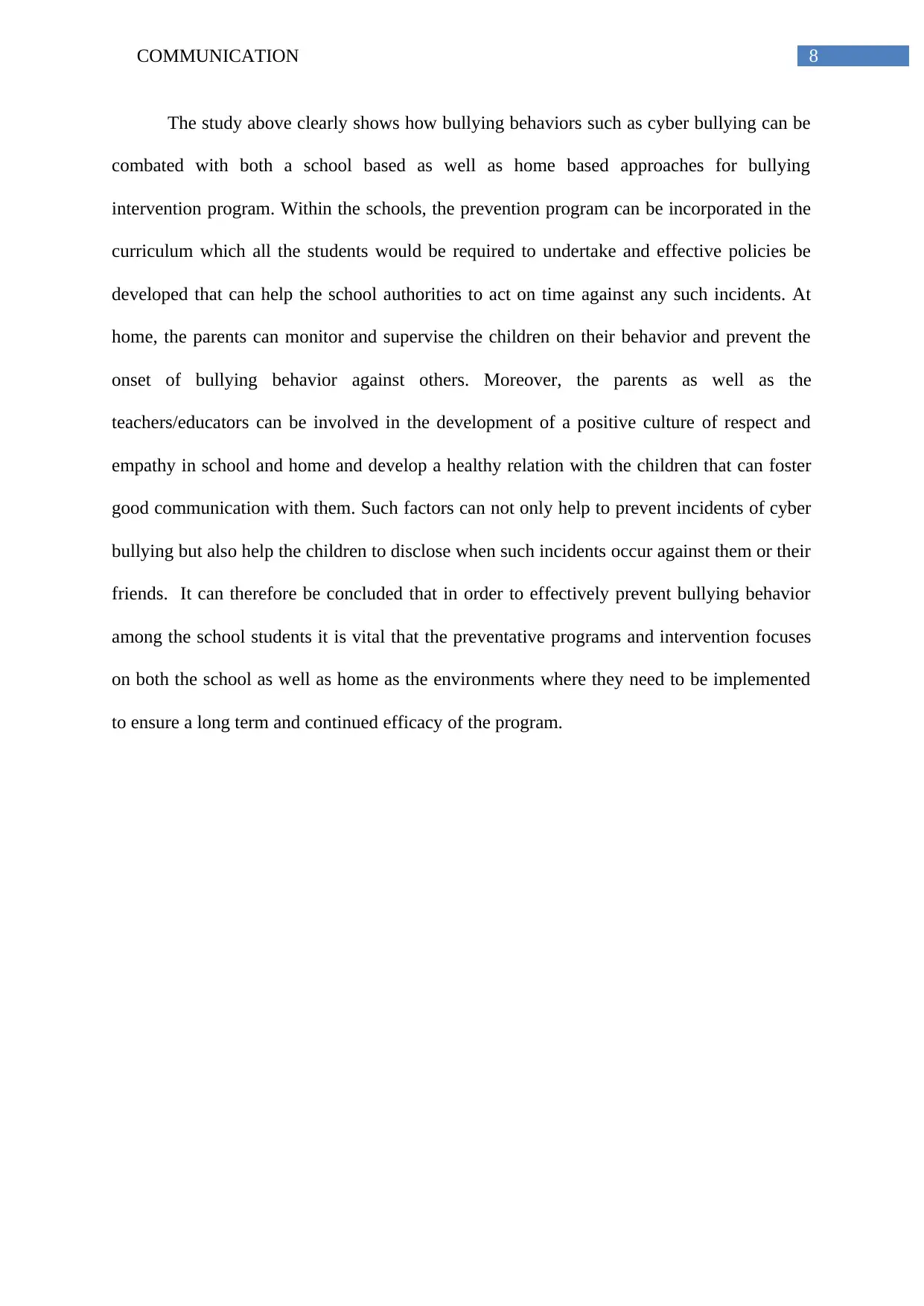
8COMMUNICATION
The study above clearly shows how bullying behaviors such as cyber bullying can be
combated with both a school based as well as home based approaches for bullying
intervention program. Within the schools, the prevention program can be incorporated in the
curriculum which all the students would be required to undertake and effective policies be
developed that can help the school authorities to act on time against any such incidents. At
home, the parents can monitor and supervise the children on their behavior and prevent the
onset of bullying behavior against others. Moreover, the parents as well as the
teachers/educators can be involved in the development of a positive culture of respect and
empathy in school and home and develop a healthy relation with the children that can foster
good communication with them. Such factors can not only help to prevent incidents of cyber
bullying but also help the children to disclose when such incidents occur against them or their
friends. It can therefore be concluded that in order to effectively prevent bullying behavior
among the school students it is vital that the preventative programs and intervention focuses
on both the school as well as home as the environments where they need to be implemented
to ensure a long term and continued efficacy of the program.
The study above clearly shows how bullying behaviors such as cyber bullying can be
combated with both a school based as well as home based approaches for bullying
intervention program. Within the schools, the prevention program can be incorporated in the
curriculum which all the students would be required to undertake and effective policies be
developed that can help the school authorities to act on time against any such incidents. At
home, the parents can monitor and supervise the children on their behavior and prevent the
onset of bullying behavior against others. Moreover, the parents as well as the
teachers/educators can be involved in the development of a positive culture of respect and
empathy in school and home and develop a healthy relation with the children that can foster
good communication with them. Such factors can not only help to prevent incidents of cyber
bullying but also help the children to disclose when such incidents occur against them or their
friends. It can therefore be concluded that in order to effectively prevent bullying behavior
among the school students it is vital that the preventative programs and intervention focuses
on both the school as well as home as the environments where they need to be implemented
to ensure a long term and continued efficacy of the program.
⊘ This is a preview!⊘
Do you want full access?
Subscribe today to unlock all pages.

Trusted by 1+ million students worldwide
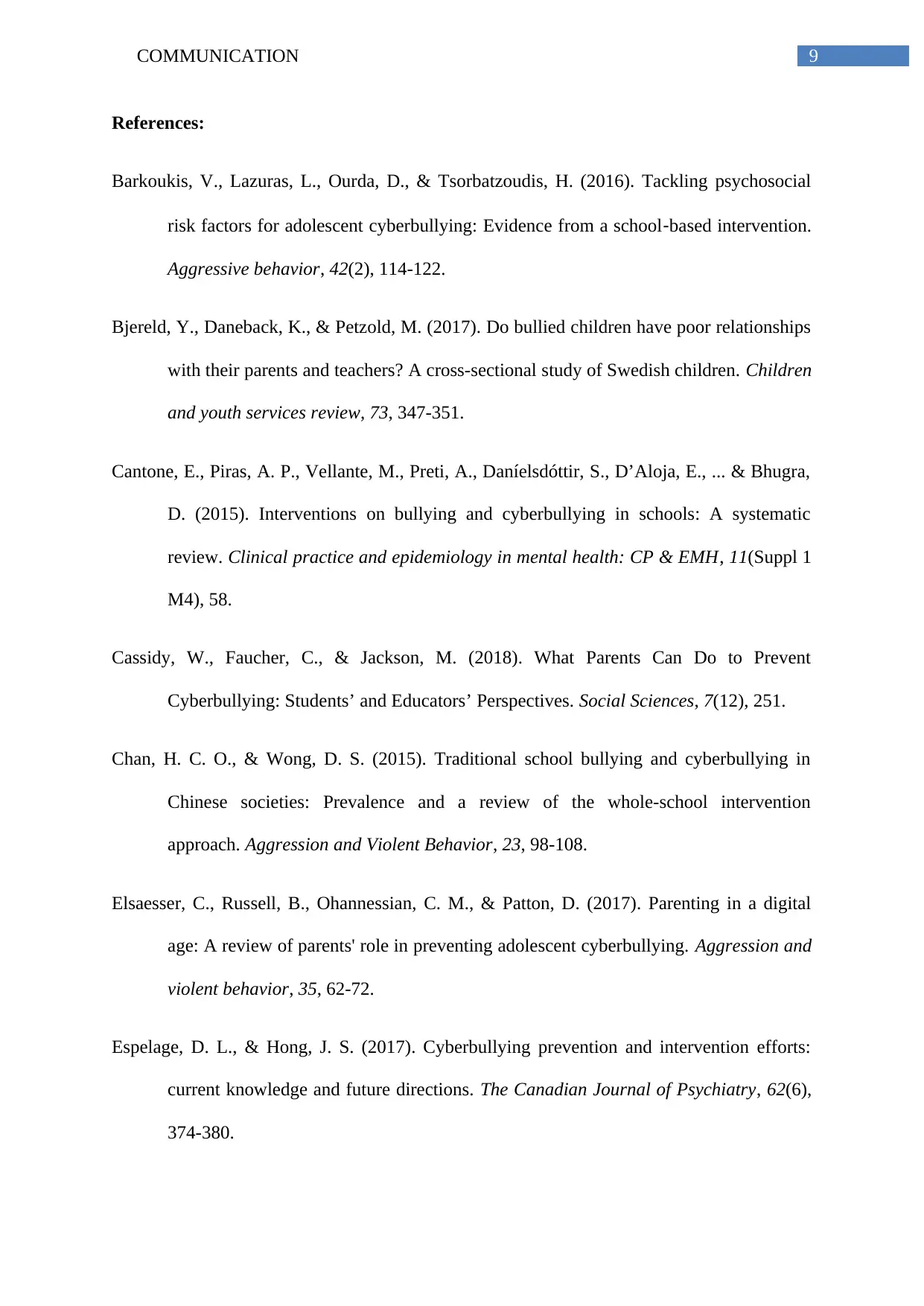
9COMMUNICATION
References:
Barkoukis, V., Lazuras, L., Ourda, D., & Tsorbatzoudis, H. (2016). Tackling psychosocial
risk factors for adolescent cyberbullying: Evidence from a school‐based intervention.
Aggressive behavior, 42(2), 114-122.
Bjereld, Y., Daneback, K., & Petzold, M. (2017). Do bullied children have poor relationships
with their parents and teachers? A cross-sectional study of Swedish children. Children
and youth services review, 73, 347-351.
Cantone, E., Piras, A. P., Vellante, M., Preti, A., Daníelsdóttir, S., D’Aloja, E., ... & Bhugra,
D. (2015). Interventions on bullying and cyberbullying in schools: A systematic
review. Clinical practice and epidemiology in mental health: CP & EMH, 11(Suppl 1
M4), 58.
Cassidy, W., Faucher, C., & Jackson, M. (2018). What Parents Can Do to Prevent
Cyberbullying: Students’ and Educators’ Perspectives. Social Sciences, 7(12), 251.
Chan, H. C. O., & Wong, D. S. (2015). Traditional school bullying and cyberbullying in
Chinese societies: Prevalence and a review of the whole-school intervention
approach. Aggression and Violent Behavior, 23, 98-108.
Elsaesser, C., Russell, B., Ohannessian, C. M., & Patton, D. (2017). Parenting in a digital
age: A review of parents' role in preventing adolescent cyberbullying. Aggression and
violent behavior, 35, 62-72.
Espelage, D. L., & Hong, J. S. (2017). Cyberbullying prevention and intervention efforts:
current knowledge and future directions. The Canadian Journal of Psychiatry, 62(6),
374-380.
References:
Barkoukis, V., Lazuras, L., Ourda, D., & Tsorbatzoudis, H. (2016). Tackling psychosocial
risk factors for adolescent cyberbullying: Evidence from a school‐based intervention.
Aggressive behavior, 42(2), 114-122.
Bjereld, Y., Daneback, K., & Petzold, M. (2017). Do bullied children have poor relationships
with their parents and teachers? A cross-sectional study of Swedish children. Children
and youth services review, 73, 347-351.
Cantone, E., Piras, A. P., Vellante, M., Preti, A., Daníelsdóttir, S., D’Aloja, E., ... & Bhugra,
D. (2015). Interventions on bullying and cyberbullying in schools: A systematic
review. Clinical practice and epidemiology in mental health: CP & EMH, 11(Suppl 1
M4), 58.
Cassidy, W., Faucher, C., & Jackson, M. (2018). What Parents Can Do to Prevent
Cyberbullying: Students’ and Educators’ Perspectives. Social Sciences, 7(12), 251.
Chan, H. C. O., & Wong, D. S. (2015). Traditional school bullying and cyberbullying in
Chinese societies: Prevalence and a review of the whole-school intervention
approach. Aggression and Violent Behavior, 23, 98-108.
Elsaesser, C., Russell, B., Ohannessian, C. M., & Patton, D. (2017). Parenting in a digital
age: A review of parents' role in preventing adolescent cyberbullying. Aggression and
violent behavior, 35, 62-72.
Espelage, D. L., & Hong, J. S. (2017). Cyberbullying prevention and intervention efforts:
current knowledge and future directions. The Canadian Journal of Psychiatry, 62(6),
374-380.
Paraphrase This Document
Need a fresh take? Get an instant paraphrase of this document with our AI Paraphraser
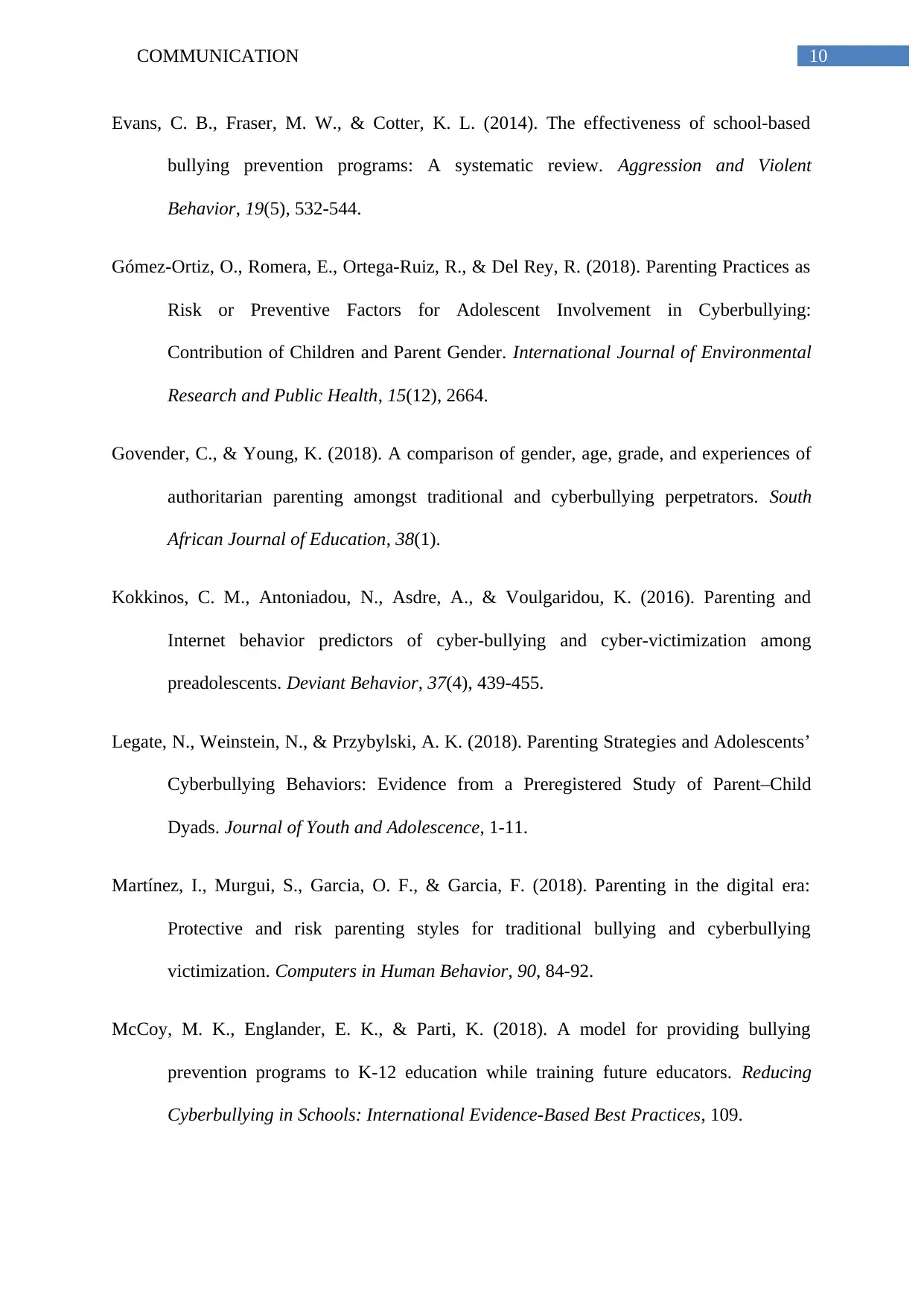
10COMMUNICATION
Evans, C. B., Fraser, M. W., & Cotter, K. L. (2014). The effectiveness of school-based
bullying prevention programs: A systematic review. Aggression and Violent
Behavior, 19(5), 532-544.
Gómez-Ortiz, O., Romera, E., Ortega-Ruiz, R., & Del Rey, R. (2018). Parenting Practices as
Risk or Preventive Factors for Adolescent Involvement in Cyberbullying:
Contribution of Children and Parent Gender. International Journal of Environmental
Research and Public Health, 15(12), 2664.
Govender, C., & Young, K. (2018). A comparison of gender, age, grade, and experiences of
authoritarian parenting amongst traditional and cyberbullying perpetrators. South
African Journal of Education, 38(1).
Kokkinos, C. M., Antoniadou, N., Asdre, A., & Voulgaridou, K. (2016). Parenting and
Internet behavior predictors of cyber-bullying and cyber-victimization among
preadolescents. Deviant Behavior, 37(4), 439-455.
Legate, N., Weinstein, N., & Przybylski, A. K. (2018). Parenting Strategies and Adolescents’
Cyberbullying Behaviors: Evidence from a Preregistered Study of Parent–Child
Dyads. Journal of Youth and Adolescence, 1-11.
Martínez, I., Murgui, S., Garcia, O. F., & Garcia, F. (2018). Parenting in the digital era:
Protective and risk parenting styles for traditional bullying and cyberbullying
victimization. Computers in Human Behavior, 90, 84-92.
McCoy, M. K., Englander, E. K., & Parti, K. (2018). A model for providing bullying
prevention programs to K-12 education while training future educators. Reducing
Cyberbullying in Schools: International Evidence-Based Best Practices, 109.
Evans, C. B., Fraser, M. W., & Cotter, K. L. (2014). The effectiveness of school-based
bullying prevention programs: A systematic review. Aggression and Violent
Behavior, 19(5), 532-544.
Gómez-Ortiz, O., Romera, E., Ortega-Ruiz, R., & Del Rey, R. (2018). Parenting Practices as
Risk or Preventive Factors for Adolescent Involvement in Cyberbullying:
Contribution of Children and Parent Gender. International Journal of Environmental
Research and Public Health, 15(12), 2664.
Govender, C., & Young, K. (2018). A comparison of gender, age, grade, and experiences of
authoritarian parenting amongst traditional and cyberbullying perpetrators. South
African Journal of Education, 38(1).
Kokkinos, C. M., Antoniadou, N., Asdre, A., & Voulgaridou, K. (2016). Parenting and
Internet behavior predictors of cyber-bullying and cyber-victimization among
preadolescents. Deviant Behavior, 37(4), 439-455.
Legate, N., Weinstein, N., & Przybylski, A. K. (2018). Parenting Strategies and Adolescents’
Cyberbullying Behaviors: Evidence from a Preregistered Study of Parent–Child
Dyads. Journal of Youth and Adolescence, 1-11.
Martínez, I., Murgui, S., Garcia, O. F., & Garcia, F. (2018). Parenting in the digital era:
Protective and risk parenting styles for traditional bullying and cyberbullying
victimization. Computers in Human Behavior, 90, 84-92.
McCoy, M. K., Englander, E. K., & Parti, K. (2018). A model for providing bullying
prevention programs to K-12 education while training future educators. Reducing
Cyberbullying in Schools: International Evidence-Based Best Practices, 109.
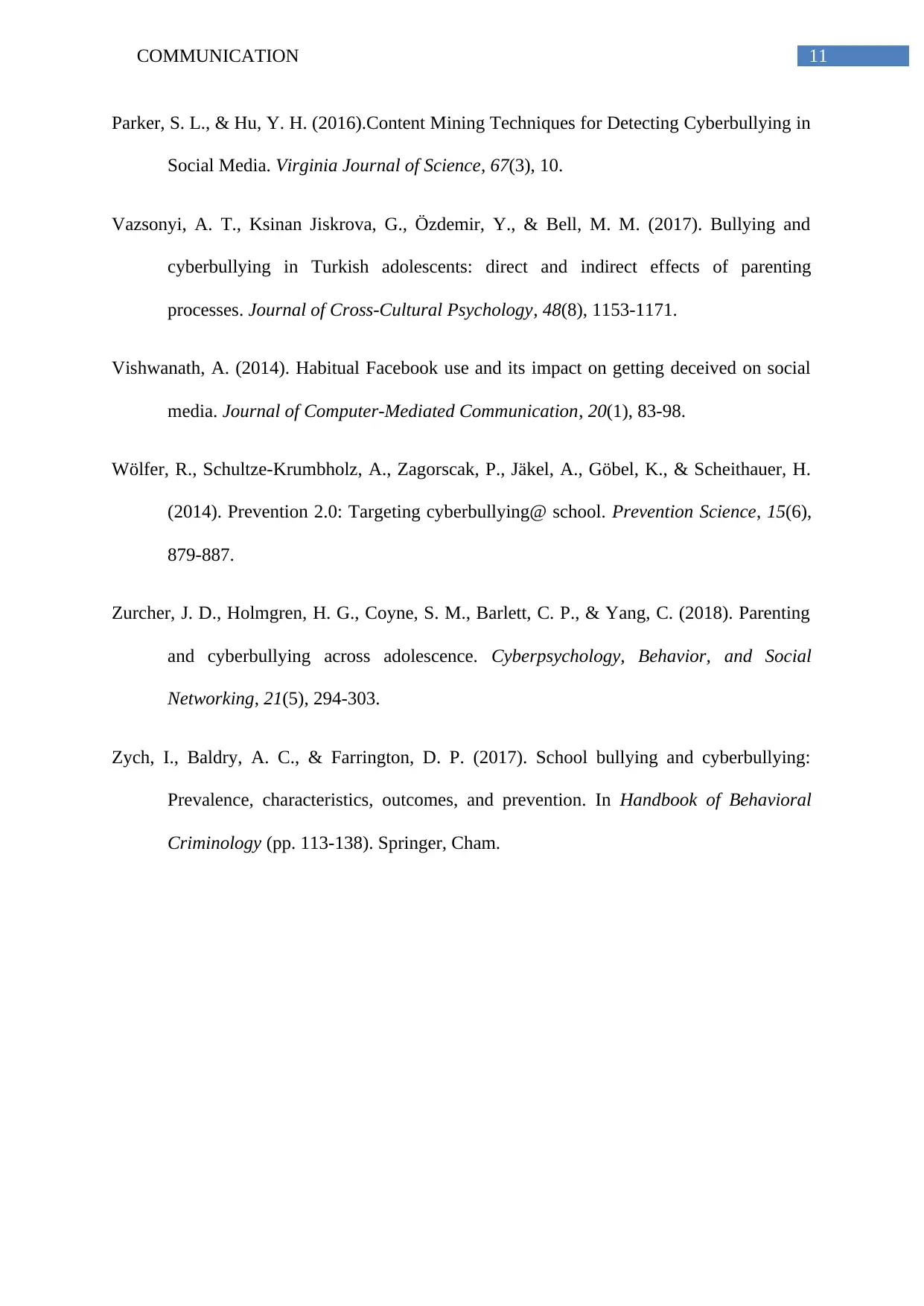
11COMMUNICATION
Parker, S. L., & Hu, Y. H. (2016).Content Mining Techniques for Detecting Cyberbullying in
Social Media. Virginia Journal of Science, 67(3), 10.
Vazsonyi, A. T., Ksinan Jiskrova, G., Özdemir, Y., & Bell, M. M. (2017). Bullying and
cyberbullying in Turkish adolescents: direct and indirect effects of parenting
processes. Journal of Cross-Cultural Psychology, 48(8), 1153-1171.
Vishwanath, A. (2014). Habitual Facebook use and its impact on getting deceived on social
media. Journal of Computer-Mediated Communication, 20(1), 83-98.
Wölfer, R., Schultze-Krumbholz, A., Zagorscak, P., Jäkel, A., Göbel, K., & Scheithauer, H.
(2014). Prevention 2.0: Targeting cyberbullying@ school. Prevention Science, 15(6),
879-887.
Zurcher, J. D., Holmgren, H. G., Coyne, S. M., Barlett, C. P., & Yang, C. (2018). Parenting
and cyberbullying across adolescence. Cyberpsychology, Behavior, and Social
Networking, 21(5), 294-303.
Zych, I., Baldry, A. C., & Farrington, D. P. (2017). School bullying and cyberbullying:
Prevalence, characteristics, outcomes, and prevention. In Handbook of Behavioral
Criminology (pp. 113-138). Springer, Cham.
Parker, S. L., & Hu, Y. H. (2016).Content Mining Techniques for Detecting Cyberbullying in
Social Media. Virginia Journal of Science, 67(3), 10.
Vazsonyi, A. T., Ksinan Jiskrova, G., Özdemir, Y., & Bell, M. M. (2017). Bullying and
cyberbullying in Turkish adolescents: direct and indirect effects of parenting
processes. Journal of Cross-Cultural Psychology, 48(8), 1153-1171.
Vishwanath, A. (2014). Habitual Facebook use and its impact on getting deceived on social
media. Journal of Computer-Mediated Communication, 20(1), 83-98.
Wölfer, R., Schultze-Krumbholz, A., Zagorscak, P., Jäkel, A., Göbel, K., & Scheithauer, H.
(2014). Prevention 2.0: Targeting cyberbullying@ school. Prevention Science, 15(6),
879-887.
Zurcher, J. D., Holmgren, H. G., Coyne, S. M., Barlett, C. P., & Yang, C. (2018). Parenting
and cyberbullying across adolescence. Cyberpsychology, Behavior, and Social
Networking, 21(5), 294-303.
Zych, I., Baldry, A. C., & Farrington, D. P. (2017). School bullying and cyberbullying:
Prevalence, characteristics, outcomes, and prevention. In Handbook of Behavioral
Criminology (pp. 113-138). Springer, Cham.
⊘ This is a preview!⊘
Do you want full access?
Subscribe today to unlock all pages.

Trusted by 1+ million students worldwide
1 out of 12
Related Documents
Your All-in-One AI-Powered Toolkit for Academic Success.
+13062052269
info@desklib.com
Available 24*7 on WhatsApp / Email
![[object Object]](/_next/static/media/star-bottom.7253800d.svg)
Unlock your academic potential
Copyright © 2020–2025 A2Z Services. All Rights Reserved. Developed and managed by ZUCOL.





